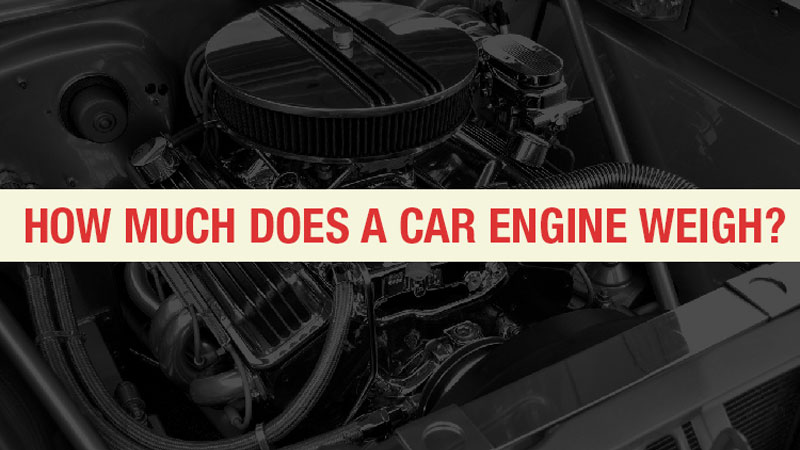When you start contemplating the mechanics that propel an automobile down the road, one crucial, yet often overlooked component stands out: the engine. As the heart of the vehicle, the engine is responsible for converting fuel into motion, but have you ever considered how much this powerhouse weighs? Indeed, engine weight is a fascinating topic, one that often eludes car enthusiasts and everyday drivers alike. In this exploration, we’ll pull back the curtain on the intricacies of engine weight, revealing how it affects performance, design, and efficiency.
To set the stage, let’s dive into the basic measurements. On average, a car engine weighs anywhere between 300 to 800 pounds, with significant variability depending on a multitude of factors. The type of engine—whether it be an inline four-cylinder, a V6, or a formidable V8—plays a pivotal role in determining its weight. For instance, an inline four-cylinder engine typically tips the scales at around 300 to 400 pounds, while the robust V8 can weigh in well over 600 pounds. This disparity stems from the number of cylinders, materials used in construction, and engine design intricacies.
Interestingly, the materials chosen for constructing an engine significantly influence its weight. Traditional cast iron engines are notoriously heavier than their aluminum counterparts. While cast iron engines come with the advantage of durability and lower production costs, aluminum offers a laudable lightweight alternative. Engineers are increasingly turning to composite materials and advanced alloys in response to the demand for lighter weights, demonstrating the innovative strides in automotive engineering.
Now, you may wonder, why does engine weight matter? The implications of engine weight extend far beyond mere numbers. Weight has a cascading effect on vehicle performance, handling, fuel efficiency, and even safety. A lighter engine can enhance a vehicle’s acceleration, allowing it to become more responsive and agile. Conversely, heavier engines, while providing more power, may contribute to decreased fuel efficiency and handling challenges. This is particularly evident in high-performance vehicles, where every ounce matters in balancing speed and control.
Moreover, engine weight contributes to the overall weight of the vehicle, which has repercussions for various vital performance metrics. For instance, as weight increases, the vehicle’s braking system must also adapt to cope with the additional mass. Heavy engines can lead to longer stopping distances, while lighter counterparts offer quicker response times. Thus, manufacturers face the perennial challenge of striking the ideal balance between power and weight.
Another intriguing aspect of engine weight lies in its coupling with technology. The emergence of hybrid and electric vehicles has forged a new path in the realm of engine engineering. In hybrids, the combination of a conventional engine with an electric motor introduces unique weight considerations. The necessity of an additional power source adds complexity to automotive design, prompting engineers to explore ways to minimize the weight of both the engine and battery systems to maximize efficiency. Electric motors are typically lighter than internal combustion engines, paving the way for vehicles that not only possess greater range but also enhanced performance due to lower overall weight.
Furthermore, the quest for weight reduction goes beyond just the engine. It is a holistic approach that encompasses the entire vehicle structure, from the frame to the wheels. Car manufacturers are employing lightweight materials such as carbon fiber and high-strength steel, allowing them to ensure that the benefits of a lighter engine are not negated by heavier components elsewhere. Thus, the era of lightweight engineering is dawning, and engines are at the forefront of this transformative movement.
Pondering on the future, we are bound to see even more significant shifts in engine designs and weights. As we venture further into an era characterized by electric vehicles, the integration of advanced technologies like artificial intelligence and machine learning will play a pivotal role in optimizing engine performance and weight. The future promises not only lighter engines but also hyper-efficient systems that are capable of adjusting their function for maximum efficiency based on real-time data.
Additionally, while lighter engines are a boon for performance and efficiency, they also present their own set of challenges. For instance, achieving a lightweight design often necessitates the trade-off of robustness and longevity. More fragile components may be prone to wear and tear, eventually leading to a conversation about maintenance and repair. The automotive realm is in constant flux, as engineers continually grapple with ensuring that advancements in weight reduction do not compromise the iconic strength and reliability associated with traditional engines.
In conclusion, understanding the weight of car engines offers a window into the broader narrative of automotive engineering. As you take a moment to contemplate that essential piece of machinery under the hood, remember that it is not merely a source of propulsion; it is a finely-tuned element that embodies the ongoing quest for efficiency, performance, and innovation. Whether you are a gearhead or simply a curious driver, recognizing the significance of engine weight will surely enrich your appreciation for the marvels of automotive technology. And who knows, it may even spark a newfound fascination for the intricacies of the vehicles that move us every day.
